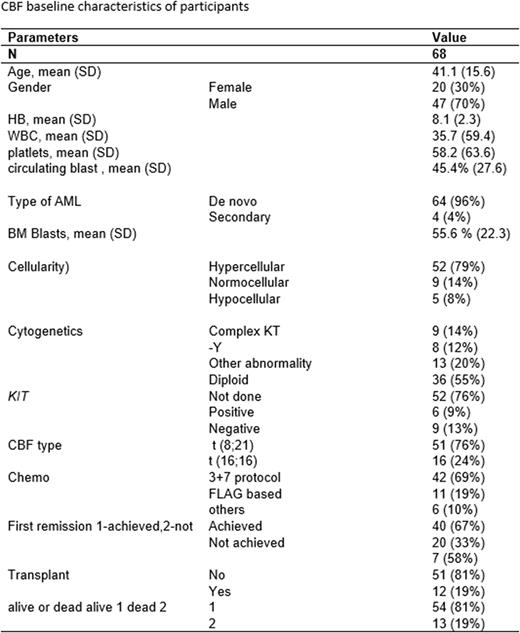Abstract
Background: Acute myeloid leukemia (AML) is a myeloid neoplasm, further sub- classified based on morphology, or cytogenetics, molecular genetics among other clinical and pathologic factors. AML with Core-binding factor rearrangement is cytogenetically defined by the presence of t(8;21) (q22;q22) or inv(16)(p13q22)/t(16;16)(p13;q22), commonly abbreviated as t(8;21) and inv(16), respectively or AML-CBF. According to World Health Organization (WHO) classification of myeloid neoplasms, patients with the recurring cytogenetic abnormalities t(8;21)(q22;q22), inv(16)(p13q22) or t(16;16)(p13;q22), should be considered to have (AML) even if the blast percentage is less than 20%. AML-CBF is historically known as good prognosis group of AML.
This is an entirely retrospective study aiming to analyze the clinicopathologic characteristics for cases of AML-CBF in tertiary cancer center.
Methods: We retrospectively analyzed data from the clinical database of our single tertiary hematology center, The National Center for Cancer Care and Research, Doha, Qatar. All patients diagnosed with AML and CBF during the period of January 2013 to December 2021.
Results: Sixty-eight patients with CBF were identified. Males were predominant 47/68 (70 %) with a median age of 41 years (range, 18-77). At diagnosis, the Complete blood count showed a median hemoglobin of 8.1 g/dl, white blood cells of 35 x10^3/uL and platelets 58 x10^3/uL, median blast percentage of 45% in peripheral blood and 55 % in bone marrow (BM). BM shows marked hypercellularity in the majority of patients (79%) and was hypocellular in only 5 cases (8%). Sixty-Four patients (96%) had de novo AML, while 4 patients (4%) had secondary AML (therapy related).
Subanalysis by age, < 40 years (n=36)(52%), in comparison to AML-CBF above 40 years, showed that the younger group had higher total leukocytic count 53 x10^3/uL compared to 15 x10^3/Ul in patients >40 (p=0.009), higher peripheral blasts (55 %) compared to 33 % (p=0.001) and higher BM blastS 61 % vs 48 % (p=0.05) and no therapy related cases (p =0.01).
t (8; 21) was more frequent than inv(16)(p13q22)/t(16;16)(p13;q22 76% vs 24 % in AML-CBF with less than 40 years. The most detected cytogenetics abnormalities associated with CBF rearrangements were diploid cytogenetics in 35 patients (54%), followed by Complex KT in 9 patients (14%), -Y in 8(13 %). FLT 3-ITD was positive in 4/48 patients (8%), while NPM1 mutation was detected in 5/52.Kit mutation was positive in 6/15 patients (40%). Anthracycline-Cytarabine based regimen (3+7) was used most common as induction chemotherapy in 42 patients (69%), followed by Fludarabine-Cytarabine-Anthracycline (FLAG-Ida) regimen in 19 % of cases. Remission achieved in 67% of the patients after induction therapy. Twelve patients (19%) underwent allogenic bone marrow transplant. Patient characteristics are described in Table 1.
The median overall survival (OS) was 81 %, with median of 37 months and progression free survival (PFS) 34 months. There was no statistically significant difference between FLT 3-ITD-positive and negative cases (p=0.2) or patients who had t (8; 21) vs t (16; 16) (p=0.8) or patient with complex karyotype (p=0.2). The progression free survival PFS for non-transplanted patients vs transplanted 20 months vs 16 months (p=0.8)
Conclusion: AML with CBF is different and interesting subtype of AML. In our study, the majority of patients were young males with more prevalent t (8; 21). Younger patients (less than 40 years) with AML-CBF has higher WBCs and blasts percentage with less incidence of secondary AML. Association with complex karyotype or FLT 3-ITD wasn't show statistically significant inferior out come in our cohort and transplanted patients didn't show statistically significant advantage. This study is limited by sample size
Disclosures
No relevant conflicts of interest to declare.
Author notes
Asterisk with author names denotes non-ASH members.


This feature is available to Subscribers Only
Sign In or Create an Account Close Modal